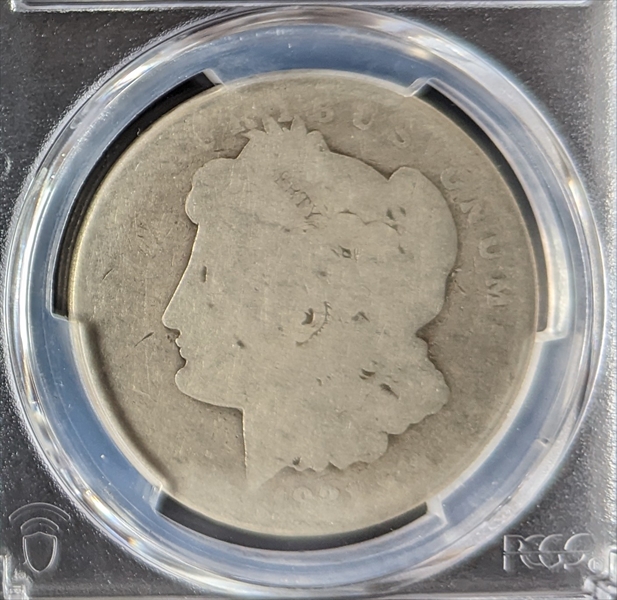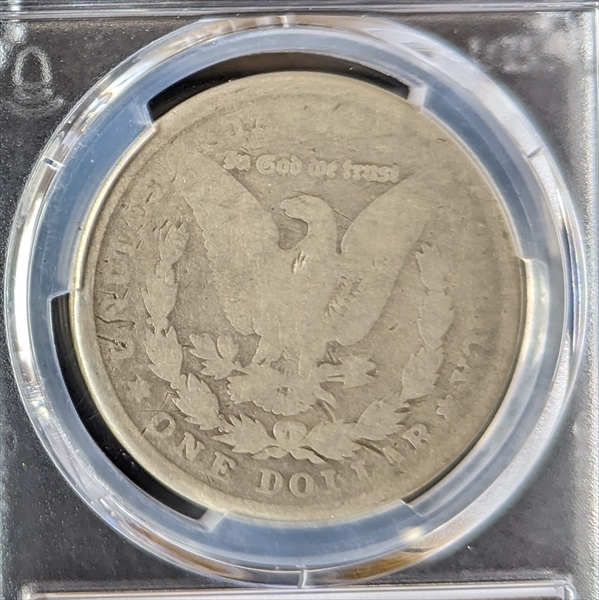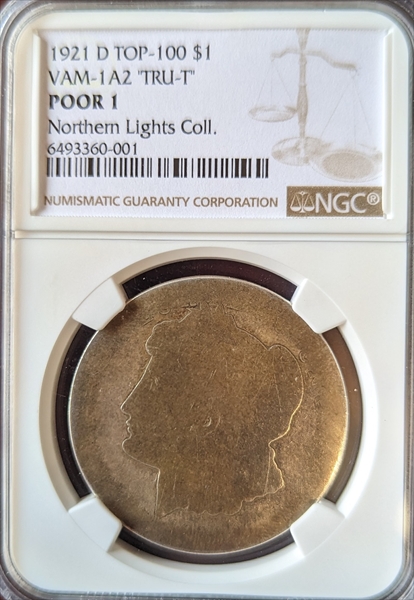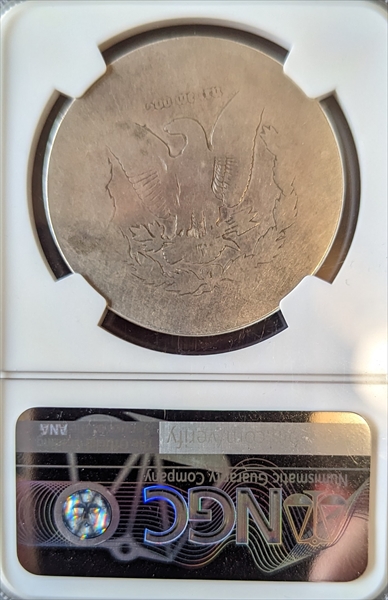1921-S $1 FR2 认证号40561875, PCGS号7300
拥有者评论
Twenty-eight (28) in lower grade.
专家评论
Q. David Bowers
The following narrative, with minor editing, is from my "Silver Dollars & Trade Dollars of the United States: A Complete Encyclopedia" (Wolfeboro, NH: Bowers and Merena Galleries, Inc., 1993).Coinage Context
San Francisco Mint. Like the Philadelphia and Denver facilities, the San Francisco Mint was pressed into service to strike large quantities of new Morgan dollars in 1921. Coinage began on May 9, 1921.
Numismatic Information
Commentary: The 1921-S dollars, like the 1921-D coins, all have a Micro S mintmark.
In B. Max Mehl's sale of the Alex J. Rosborough Collection, April 9, 1929, a 1921-S was catalogued as follows: "1921-S Microscopic S. AU. This specimen is one of the first 50 struck, secured by members of the Pacific Coast Numismatic Society." Apparently, such coins had no special surface quality apart from normal circulation strikes.
Hoard coins: Dollars of this date and mint were scarce during the 1920s, for relatively few were released. This changed when quantities were paid out from storage at the San Francisco Mint at intervals from the 1930s through the 1950s. 1921-S dollars were little esteemed in their time, thus few original mint-sealed bags were saved. Not even casino operators and other silver dollar hoarders liked the 1921 Morgan from any of the three mints. Today, while individual coins are exceedingly common, bags of 1921-S are few and far between. The Redfield estate (1976) apparently had a partial bag. The Numismatist, December 1939, told of a recent release of 1921-S Morgan dollars:
Morgan Type Dollar From San Francisco Mint: An interesting sight in the daily change around San Francisco recently has been the 1921 Morgan dollars in Mint or Uncirculated condition, some having just been released in that condition through the regular course of business.
It is thought that possibly 10 to 15 million were melted under provisions of the 1942 Silver Act. In comparison to surviving 1921 Philadelphia Mint coins, 1921-S dollars are far more elusive than the respective mintage differences (approximately 2:1) would indicate.
Circulated grades: In worn grades the 1921-S dollar is very common. An estimated two to four million survive.
Mint State grades: The usually-seen Mint State specimen is very poorly struck, has abraded surfaces, and even if the lustre is rich (as it is on some), the high points of the design are apt to be dull. Fully struck, lustrous coins exist, are scarce, and when seen are apt to be bagmarked. Of the 1921-S, Wayne Miller noted the following: "This date is by far the worst of any Morgan dollar in terms of appearance. Most are a weak mushy strike."
As is the case with other 1921 Morgan issues, grading interpretations for 1921-S are rather loose in comparison to earlier Morgan dollar dates.
My population estimates are as follows: MS-60 to 62, 1,000,000 to 2,000,000; MS-63, 200,000 to 400,000; MS-64, 30,000 to 60,000; and MS-65 or better (per current interpretations), 2,000 to 4,000.
Prooflike coins: Semi-prooflike 1921-S dollars are occasionally seen, but with far less frequency than with their Denver or Philadelphia Mint counterparts. Full prooflike pieces are great rarities; possibly fewer than a dozen exist (could these be "Zerbe Proofs," described below?). As a class, the PL and DMPL Denver Mint coins of 1921 are much scarcer than those of the Philadelphia and San Francisco mints. Be careful when buying these. See my comments under 1921 Prooflike; they also apply here.
1921-S "Zerbe Proof" dollars: The following is from an article, "Notes on 1895 Morgan Dollars," by Stuart Mosher, in the July 1955 issue of The Numismatist. While the article dealt primarily with 1895 dollars, the following anecdote was repeated concerning the 1921-S dollars:
Occasionally I notice Morgan dollars from branch mints are advertised as being in "Proof' condition. I have never seen one although I have seen many with the so-called prooflike surfaces and these I have considered as early strikings and not as intentional proofs. While they have bright surfaces, they lack the sharpness, the mirror-like finish and the wire edges of genuine Proof coins.
The scope of my observations and remarks are not intended to imply that branch mint Proofs are nonexistent. There are a lot of things I have never seen. About l0 years ago, Farran Zerbe, father of the Peace dollar and our first American numismatic missionary, told me an intriguing story regarding a branch mint Morgan dollar issued in Proof.
In 1921 he was in California awaiting the arrival of the dies that were to be used to strike the first Peace dollars at the San Francisco Mint. The mint phoned him that the dies had arrived and he hastened there to see them put into operation. The new 1921 dies had arrived all right but they turned out to be dies for the old Morgan design which had not been coined since 1904, and not the dies for the Peace dollar which he had worked so hard and long to promote.
Mr. Zerbe told me that he suggested to the chagrined mint officials that they could assuage his disappointment somewhat if they would strike off a few Morgan dollars from the new 1921 dies in Proof condition. They were happy to oblige and manufactured about two dozen which he bought and later handed out to his various coin collecting friends throughout the country. While I have never seen one of these Proofs, it is logical to suppose some of them are extant.
Somehow, the creation of these 1921 San Francisco Mint "Proofs" got translated into the existence of Philadelphia Mint coins called "Zerbe Proofs" without any reason, so far as I know. Of course, it is possible that Zerbe repeated the same scenario at the Philadelphia Mint, but if he had, he probably would have told Mosher about it. However, Walter Breen recalls a conversation he had with Wayte Raymond in 1951, to the effect that Zerbe said he had Proofs made at Philadelphia to go with his 1921- S Proofs.
Mike Carter in his monograph on 1921 Morgan dollars suggests that five 1921-5 Proofs are known to exist, one of which was sold for Leroy Lenhart for $10,000 in 1981, and another by Superior Galleries, the Wayne Miller coin, for $6,600 in 1978.
Varieties
REDESIGNED DIES: SHALLOW RELIEF
Circulation strikes:
1. All have 16 berries in wreath and Micro s mintmark. Breen-5707; Raised round dot in field: Breen-5708, so many varieties that VAM does not list (see VAM p. 125 and note on p. 395). Many minor positional varieties. All are Van Allen and Mallis Reverse D-2.
Dies prepared: Obverse: Unknown; Reverse: Unknown. Probably over 100 die pairs.
Circulation strike mintage: 21,695,000
Estimated quantity melted: Estimated 10,000,000 to 15,000,000 melted under the 1942 Silver Act, additional coins in later melts.
Approximate population G-4 to AU-58: 2,000,000 to 4,000,000 (URS-23)
Availability of prooflike coins: DMPL coins are said to be very rare; probably fewer than a dozen exist, possibly these are the so-called "Zerbe Proofs." PL coins are also rare.
Characteristics of striking: Poor; about as poor as a Morgan dollar can be.
Known hoards of Mint State coins: More or less continuously distributed by the Treasury during the 1950s and early 1960s.
Commentary
The 1921-S dollar has a Micro s mintmark.
Ron Guth
According to a notice in the June 1934 issue of The Numismatist (p. 416), collectors could still purchase Uncirculated 1921-S Morgan Dollars for "the face value of the coins and an amount sufficient to cover the mail charrges by first-class mail."
PCGS #
7300
设计师
George T. Morgan
边缘
Reeded
直径
38.10 毫米
重量
26.73 克
铸币数量
21695000
金属成分
90% Silver, 10% Copper
更高评级数量
20665
评级较低的钱币数量
30
地区
The United States of America
价格指南
PCGS 数量报告
拍卖 - PCGS 评级的
拍卖 - NGC 评级的
稀有性和存量估计 了解更多
| 所有评级 | 2167000 |
| 60或以上 | 100000 |
| 65或以上 | 2900 |
| 所有评级 | R-1.0 |
| 60或以上 | R-2.0 |
| 65或以上 | R-4.4 |
| 所有评级 | 94 / 117 TIE |
| 60或以上 | 65 / 117 TIE |
| 65或以上 | 67 / 117 TIE |
| 所有评级 | 94 / 117 TIE |
| 60或以上 | 65 / 117 TIE |
| 65或以上 | 67 / 117 TIE |

























